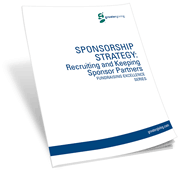

This post is the second in a series designed to open you up to a new way of viewing sponsors and their role within your nonprofit’s overall strategy. These posts are based on the “Sponsorship Strategy: Recruiting and Keeping Sponsor Partners” eBook from the Greater Giving Fundraising Excellence Series. Each new post focuses on a different part of your sponsor strategy and how best to leverage your value for the greatest mutual benefit. View all released series articles—Sponsorship Strategies
Sometimes it doesn’t matter how good your pitch is, or how well you’ve analyzed your nonprofit’s value-add to a potential sponsor; or whether you’ve already thought of all the great ways you and your target sponsor can help each other out, lift each other up, reach new audiences and new potential customers.
They still might say, “Nope, sorry! Not right now.”
Because sometimes the money just isn’t there, as much as your target sponsor wishes it were! The business you’ve pitched could want more than anything to contribute to your effort, to be a part of your vision, but the timing isn’t quite right for them or their budget.
So before you spend all that time drawing up a great pitch, and before you sit down to that meeting where you make the big ask, do a little bit of research—and avoid wasting time when it would be better spent later.
Step One: Seek out the decision-maker.
When you manage to get someone from your target sponsor company sitting down for a one-on-one interview, the first thing you should do is to find out when they make their budgeting decisions. Some organizations operate on a calendar year, and others a fiscal year. Many start out new each year with new funds for philanthropy—and new budgeting choices to make.
If the person you get to talk to doesn’t know about funding timelines, find out who does make the budget choices each year, and arrange a separate phone call or meeting with that individual.
Step Two: Ask questions!
While you can find some answers to your questions on a business, company, or organization website (usually under the “Giving” area), sometimes you need to talk to a human being to get the rest of the information you need.
Once you do have the attention of someone who oversees funding decisions, ask these pertinent questions to give your pitch the maximum possible impact:
- When does the company, business, or organization make budgeting decisions?
- When do nonprofits need to apply to qualify for consideration in the charitable giving budget?
- How does this potential sponsor make giving decisions?
Don’t give up too soon if you don’t get the answers you want, because probably the most important question you should ask is:
- Is it too late to apply?
Just because a certain deadline has passed doesn’t necessarily mean you’re out of luck. Don’t make assumptions—always ask! And be sure to put the question to a decision-maker who can give you an accurate answer.
Step Three: Plan ahead and design a sponsor pitch strategy.
 No matter how optimistic we are going into a meeting, sometimes the answers we get to those questions aren’t ideal. Maybe the potential sponsor has just finished drawing up a budget and already allocated all its charitable dollars for this fiscal year, and won’t have any more available until next year. Maybe the timing wasn’t quite right and it’s still six months before the window opens again.
No matter how optimistic we are going into a meeting, sometimes the answers we get to those questions aren’t ideal. Maybe the potential sponsor has just finished drawing up a budget and already allocated all its charitable dollars for this fiscal year, and won’t have any more available until next year. Maybe the timing wasn’t quite right and it’s still six months before the window opens again.Think of it this way: now you know, before you’ve spent the time drawing up a pitch, and you can spend your time now on other target sponsors while putting this one on the back burner.
Now you have more time to think strategically about how you and your potential sponsor match up. Consider while you wait:
- What does your nonprofit have to offer in a sponsor partnership?
- What products or services has your potential sponsor launched since the last conversation that you can capitalize on in your pitch?
- How you can use the intervening months to build up a better relationship and rapport with the potential sponsor before you do make your pitch?
Remember: have patience. Especially now that you’re aiming for long-term, multi-year sponsorship agreements, you have to spend more time courting your sponsor and showing why a commitment of that magnitude is worthwhile. Use it to your advantage!
Once you know the timing for all of your potential sponsors, you can build a year-long sponsor strategy that takes into consideration when each of your potential sponsors is ready to hear your pitch and make budget choices.
Prioritize writing great pitches for those sponsors who will be making their decisions sooner, and give yourself more time for those sponsors whose fiscal years have just started over and won’t be ready to hear your pitch for some time. You may find out a lot more about yourself and your target sponsor between now and then that can figure into your pitch, and make you even more successful at securing that multi-year commitment!
For an in-depth look into the strategy and a detailed action plan, download the Sponsorship Strategies eBook.

